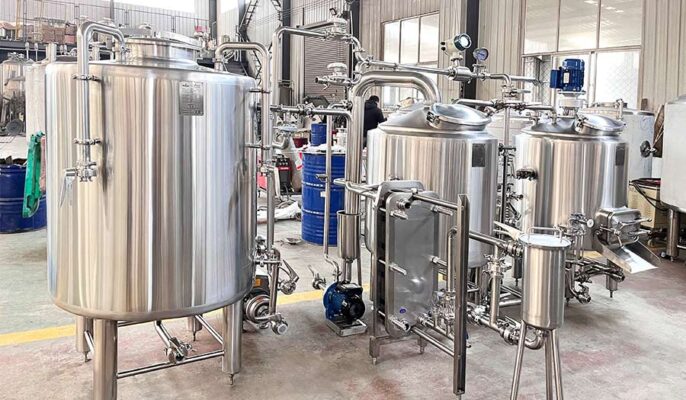ナノ醸造所は、クラフトビール業界の多くの自家醸造家にとって究極の目標かもしれない。ナノ・ブルーイング・システムとは、小規模な醸造所のことで、一般的にはユニークな手造り醸造に重点を置き、地元でサービスを提供している。クラフトビールの総生産量が急増し続ける中、従来のものより小さなバッチから醸造する醸造所の数も着実に増えている。
ナノ・ブルワリーのコンセプト
Nano breweries are typically defined as breweries or brewpub systems with an annual production of fewer than 15,000 barrels. However, this definition may vary depending on where you reside. The standard way of describing nano breweries is the one we’re using: breweries that produce 3 barrels (or fewer) of beer per batch.
必要不可欠な装備 ナノ・ブルワリー
- Brewing System: The brewing system is the heart of the brewery, and it’s crucial to choose a system that suits your needs. A basic brewing system should include mash tuns, lauter tuns, and brew kettles. You can also add features like hot liquor tanks, whirlpools, or recirculation tanks to enhance brewing capabilities.
- 発酵タンク: After brewing the wort, fermentation is needed to produce beer. Fermentation tanks come in various sizes and styles, including open and closed fermentation tanks, single tanks, and bright tanks. It’s crucial to choose fermentation tanks that fit your brewery size and have the desired features, such as temperature control and pressure release valves.
- ブライトビールタンク発酵が終わると、ビールは清澄と炭酸のためにブライトビールタンクに移されます。ブライトタンクは発酵タンクに似ていますが、異なる目的で設計されています。発酵タンク同様、ブライトタンクにも様々なサイズとスタイルがあります。
- 冷却と温度制御システム:温度管理はビール醸造にとって極めて重要であり、醸造・発酵プロセスを通じて適切な温度を維持できるシステムが不可欠です。冷却システムには、冷却器、熱交換器、冷却水を循環させるポンプなどがあります。
- 品質管理と洗浄装置pHメーター、溶存酸素メーター、分光光度計などの品質管理機器が必要です。ブラシ、ホース、洗浄剤などの洗浄機器も不可欠です。
ビールの品質は、選ぶ原料の品質に左右されます。ビールに格別な味と香りを出すには、最高品質の麦芽、ホップ、酵母、水を探すことです。地元産の原料を選べば、地域経済を支えながら、その土地ならではの風味を生み出すことができます。高品質な原材料にこだわることで、自信を持ってお客様にプレミアムな商品をお届けすることができます。

ナノ醸造システムの種類
市場にはさまざまなタイプのナノ醸造システムがあり、それぞれ異なる醸造ニーズや容量要件を満たすように設計されている。
- 統合システム:マッシング、煮沸、発酵の各工程を1つのユニットにまとめたコンパクトなシステム。省スペースで、小規模醸造者や実験的バッチに最適です。
- モジュラーシステム:一体型ユニットよりも拡張性が高く、醸造規模が拡大しても、発酵タンクやボイラーなど個々のコンポーネントを追加したりアップグレードしたりできる。拡張性があり、将来の生産拡大を見込む醸造業者に適している。
- 自動化システム:温度管理、攪拌、原料添加など、さまざまな醸造工程を自動化する技術。醸造結果が安定し、手作業が少なくて済む。
- 重力送りシステム:重力を利用して麦汁を容器から容器に移すシステム。ポンプや部品が少なく、故障のリスクが少ない。
- RIMS(Recirculating Infusion Mash System)とHERMS(Heat Exchange Recirculating Mash System):RIMSは電気ヒーターで麦汁を循環加熱し、HERMSは熱交換器を使用する。マッシュプロセス中の温度制御は正確です。
最適なナノ醸造システムを選ぶには?
- Evaluate Your Brewing Needs: Before selecting equipment, you need to assess your brewing requirements. This includes evaluating the types of beer you plan to brew, the brewing processes you’ll use, and the space available. This will help determine the size and specifications of the equipment you need.
- 目標生産量の決定:考慮すべきもう一つの重要な要素は、目標生産量です。これによって、必要な機器の容量や、発酵タンク、ブライトタンク、その他の必要なコンポーネントの数を決定することができます。
- 予算を見極める:ナノ醸造設備を選ぶ際には、予算も重要な検討事項です。ビールの品質を落とさず、ビジネスを危険にさらすことなく、どれだけの設備投資が可能かを見極める必要があります。
- Research Equipment Manufacturers: Once you have a clear understanding of your brewing needs and budget, it’s time to research equipment manufacturers. Look for companies with a good reputation in the industry and a track record of providing quality equipment. Micet Group can provide you with custom turnkey solutions to meet all your brewing equipment needs.
- 専門家のアドバイスを求める:最後に、他の醸造者や業界の専門家に専門的なアドバイスを求めましょう。彼らは経験に基づいた貴重な見識やアドバイスを提供してくれるので、コストのかかる失敗を避けることができる。
ナノ醸造所は儲かるか?
The craft beer industry has seen significant growth, with nano breweries becoming a popular choice for aspiring beer enthusiasts. If you’re considering starting a nano brewery, you might wonder if it can be profitable. Micet group introduces the following factors.
ナノ醸造所の収益性を決定する要因はいくつかある:
- 市場の需要:ナノ・ブルワリーが収益を上げるには、クラフトビールに対する地元の需要を満たす必要がある。ターゲットの嗜好をリサーチし、市場で際立つユニークで高品質なビールを作ることに集中しましょう。
- コスト管理:ナノ・ブリュワリーの管理コストは通常、大規模なブリュワリーよりも低い。しかし、家賃、光熱費、原材料費、人件費などの経費を慎重に計画・管理することが収益性を高める上で重要である。
- 効率的な生産:醸造プロセスを最適化することで、無駄を最小限に抑え、歩留まりを最大化する。これには、ナノ醸造所の特定のニーズを満たす適切な商業醸造機器の選択が含まれます。
- 価格戦略:製造コスト、目標利益率、競合他社の価格設定などの要因を考慮し、ビールの最適価格を決定する。
- 販売と流通:強力な販売戦略を確立し、バー、地元パブ、レストラン、小売流通チャネルを活用して収益を最大化する。
- マーケティングとブランディング人目を引くブランド・イメージを作り、認知度を高めて顧客を惹きつけるためのマーケティング活動に投資する。
ナノ醸造所システムを確立するには?
- 市場調査地元のクラフトビールの状況を理解し、潜在的な市場を特定し、消費者の嗜好を測定して製品を調整する。
- 事業計画を立てる:現地の規制を調査し、必要な許認可を取得し、設備、場所、原材料、人員、マーケティングを網羅した予算の概要を作成する。
- 場所とスペース醸造作業、テイスティング・ルーム(必要な場合)、将来の拡張に十分なスペースのある適切な場所を選ぶ。
- 適切な機器を選ぶ:製造予定のバッチサイズに基づき、マッシュタン、発酵タンク、醸造釜、冷却装置、洗浄装置などを考慮して醸造設備を選ぶ。
- 醸造所のセットアップ醸造設備を設置・設定し、安全基準と機能要件を満たすようにします。
- Create Unique Recipes: Experiment and refine your beer recipes to offer diverse and unique flavors that align with your brewery’s characteristics.
- 醸造プロセス:マッシング、煮沸、発酵、コンディショニング、パッケージングを含む醸造プロセスを実行し、ビールの各バッチの一貫性と品質を確保する。
- マーケティング戦略:ソーシャルメディア、地域イベント、コラボレーション、試飲会などを活用し、ブランドの認知度を高め、地域社会との関わりを深める。




